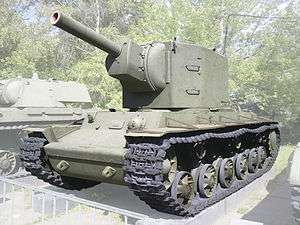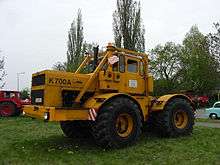Kirov Plant
 | |
| Machine-building plant | |
| Industry | Mechanical engineering |
| Founded | February 28, 1801 |
| Founder | Under the decree of emperor Paul I |
| Headquarters | Saint Petersburg, Russia |
Area served | Coast Gulf of Finland |
Key people | General director George Semenenko |
| Products | Tractors, escalators etc |
The Kirov Plant, Kirov Factory or Leningrad Kirov Plant (LKZ) (Russian: Кировский Завод, tr. Kirovskiy Zavod) is a major Russian machine-building manufacturing plant in St. Petersburg, Russia. It was established in 1789, then moved to its present site in 1801 as a foundry for cannonballs.
Putilov Company
In 1868 it was purchased by Nikolay Putilov and named the Putilov Company; it initially produced rolling stock for railways. It boomed during the industrialization of the 1890s, with the work force quadrupling in a decade, reaching 12,400 in 1900. The factory traditionally produced goods for the Russian government and railway products accounted for more than half of its total output. Starting in 1900 it also produced artillery, eventually becoming a major supplier of it to the Imperial Russian Army alongside the state arsenals. By 1917 it grew into a giant enterprise that was by far the largest in the city of St. Petersburg.
Political unrest
In February 1917 strikes at the factory contributed to setting in motion the chain of events which led to the February Revolution.
Red Putilovite Plant
After the October Revolution it was renamed Red Putilovite Plant (zavod Krasny Putilovets), famous for its manufacture of the first Soviet tractors, Fordzon-Putilovets, based on the Fordson tractor. The Putilov Plant was famous because of its revolutionary traditions. In the wake of Sergey Kirov's 1934 assassination, the plant was renamed Kirov Factory No. 100.
Products
In World War II, the T-34 tank was manufactured here. Starting around 2004 the Dartz T-98 Kombat luxury armored vehicle, somewhat reminiscent of the AM General Hummer, has been constructed at the Kirov site.
Factory No. 185 (S.M. Kirov)
The Kirov Plant is sometimes confused with another Leningrad heavy weapons manufactory, Factory No. 185 (S.M. Kirov).
Picture gallery
-

A 1923 Soviet stamp featured the Soviet Fordson
-
Russian locomotive class U U-127 Lenin's 4-6-0 oil burning compound locomotive, which was built at the Putilov factory, currently preserved at the Museum of the Moscow Railway at Paveletsky Rail Terminal
-
Builder's plate, steam dome and whistle of locomotive U-127
-

Gun manufactured in Putilov factory in 1916
-

Anti-aircraft 76 mm gun manufactured in Putilov factory in 1917
-

Lenin's Rolls-Royce Silver Ghost with Kegresse track, converted by the Putilov plant, at Gorki Leninskiye
-

An Austin-Kegresse armoured car of Red Army which was damaged during the Polish–Soviet War. An area in Zhytomyr, 21 March 1920.
-

Gun manufactured in Krasny Putilovets factory in 1930
-

heavy tanks KV-2 which was built between 1940-1943
-

Kirovets K-700 tractor which was built between 1961-2000
-
K-744 Kirovets tractor which has been built since 1995
-

K-702 loader
See also
-
 Media related to Kirov Plant (factory, Saint Petersburg) at Wikimedia Commons
Media related to Kirov Plant (factory, Saint Petersburg) at Wikimedia Commons - Trams of Putilov plant
References
- Peter Gatrell (1994), Government, Industry, and Rearmament in Russia, 1900-1914: The Last Argument of Tsarism, Cambridge University Press, ISBN 0-521-46619-9.
- Workers Unrest and the Bolshevik Response in 1919 written by Vladimir Brovkin in Slavic Review, Volume 49, Issue 3, (Autumn 1990) page 358-361
External links
- Official site (Russian)
- (English)
- St Petersburg Tractor Plant Subsidiary that builds tractors and agricultural machinery.
- Kirov Plant @ globalsecurity.org (plant's military production)
Coordinates: 59°52′43″N 30°15′30″E / 59.878655°N 30.258429°E